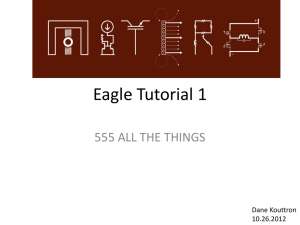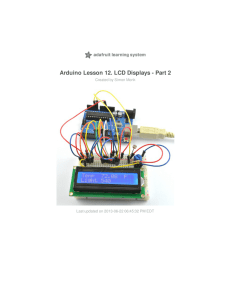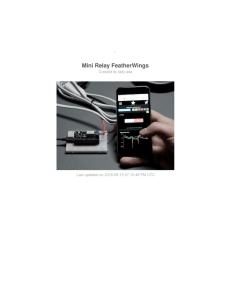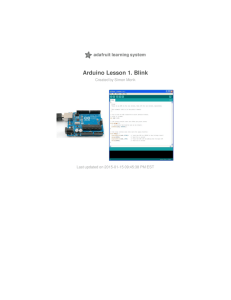Micro SD Card Breakout Board Tutorial
advertisement
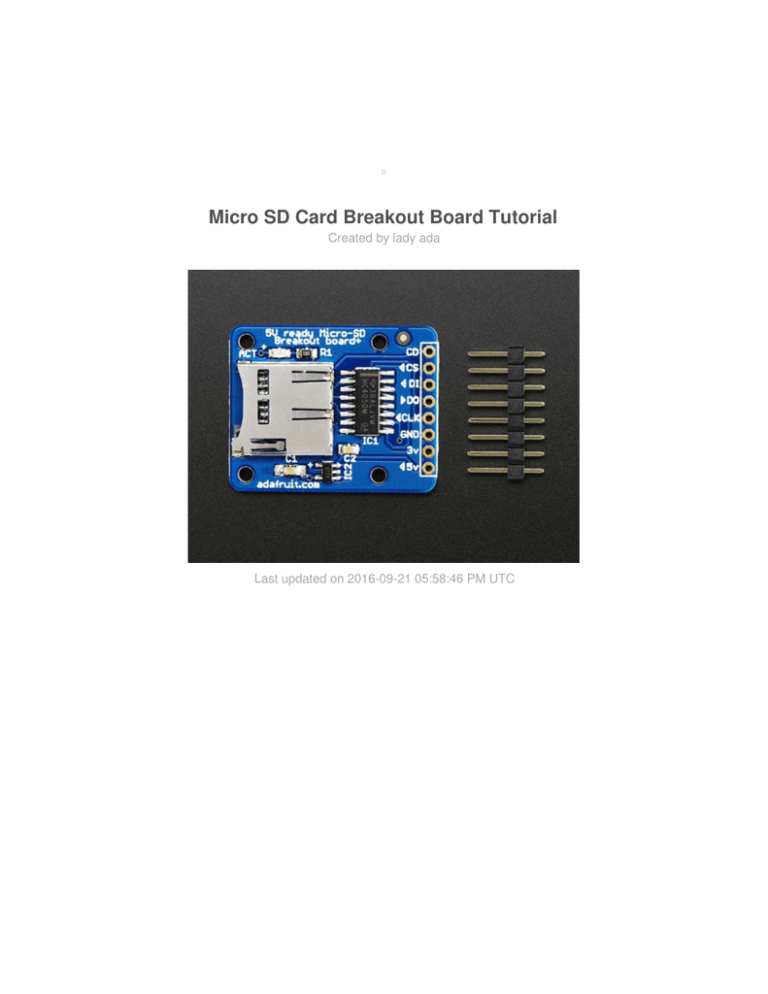
Micro SD Card Breakout Board Tutorial
Created by lady ada
Last updated on 2016-09-21 05:58:46 PM UTC
Guide Contents
Guide Contents
Introduction
Look out!
What to watch for!
Formatting notes
Wiring
Library
Arduino Library & First Test
Reading files
Reading from files
Recursively listing/reading files
Functions
2
3
6
6
7
8
10
10
15
17
18
20
Other useful functions
Examples
20
21
More examples!
21
Download
Schematic
Fabrication Print
22
22
22
© Adafruit Industries
https://learn.adafruit.com/adafruit-micro-sd-breakout-board-cardtutorial
Page 2 of 23
Introduction
If you have a project with any audio, video, graphics, data logging, etc in it, you'll find that
having a removable storage option is essential. Most microcontrollers have extremely
limited built-in storage. For example, even the Arduino Mega chip (the Atmega2560) has a
mere 4Kbytes of EEPROM storage. There's more flash (256K) but you can't write to it as
easily and you have to be careful if you want to store information in flash that you don't
overwrite the program itself!
© Adafruit Industries
https://learn.adafruit.com/adafruit-micro-sd-breakout-board-cardtutorial
Page 3 of 23
If you're doing any sort of data logging, graphics or audio, you'll need at least a megabyte
of storage, and 64 M is probably the minimum. To get that kind of storage we're going to
use the same type that's in every digital camera and mp3 player: flash cards! Often called
SD or microSD cards, they can pack gigabytes into a space smaller than a coin. They're
also available in every electronics shop so you can easily get more and best of all, many
computers have SD or microSD card readers built in so you can move data back and forth
between say your Arduino GPS data logger and your computer graphing software:
© Adafruit Industries
https://learn.adafruit.com/adafruit-micro-sd-breakout-board-cardtutorial
Page 4 of 23
© Adafruit Industries
https://learn.adafruit.com/adafruit-micro-sd-breakout-board-cardtutorial
Page 5 of 23
Look out!
What to watch for!
There are a few things to watch for when interacting with SD cards:
One is that they are strictly 3.3V devices and the power draw when writing to the card can
be fairly high, up to 100mA (or more)! That means that you must have a fairly good 3.3V
power supply for the card. Secondly you must also have 3.3V logic to interface to the pins.
We've found that SD cards are fairly sensitive about the interface pins - the newest cards
are edge triggered and require very 'square' transitions - things like resistor dividers and
long wires will have a deleterious effect on the transition speed, so keep wires short, and
avoid using resistor dividers for the 3.3V logic lines. We suggest instead using level
shifters, such as HEF4050, 74LVX245 or 74AHC125 chips.
Secondly, there are two ways to interface with SD cards -SPI mode and SDIO mode.
SDIO mode is faster, but is more complex and as far as we can tell, requires signing nondisclosure documents. For that reason, you will likely never encounter SDIO mode interface
code. Instead, every SD card has a 'lower speed' SPI mode that is easy for any
microcontroller to use. SPI mode requires four pins (we'll discuss them in detail later) so it's
not pin-heavy like some parallel-interface components
SD cards come in two popular flavors -microSD and SD. The interface, code, structure,
etc is all the same. The only differences is the size. MicroSD are much much smaller in
physical size.
Third, SD cards are 'raw' storage. They're just sectors in a flash chip, there's no structure
that you have to use. That means you could format an SD card to be a Linux filesystem, a
FAT (DOS) filesystem or a Mac filesystem. You could also not have any filesystem at all!
However, 99% of computers, cameras, MP3 players, GPS loggers, etc require FAT16 or
FAT32 for the filesystem. The tradeoff here is that for smaller microcontrollers (like the
Arduino) the addition of the complex file format handling can take a lot of flash storage and
RAM.
© Adafruit Industries
https://learn.adafruit.com/adafruit-micro-sd-breakout-board-cardtutorial
Page 6 of 23
Formatting notes
Even though you can/could use your SD card 'raw' - it's most convenient to format the card
to a filesystem. For the Arduino library we'll be discussing, and nearly every other SD
library, the card must be formatted FAT16 or FAT32. Some only allow one or the other. The
Arduino SD library can use either.
If you bought an SD card, chances are it's already pre-formatted with a FAT filesystem.
However you may have problems with how the factory formats the card, or if it's an old card
it needs to be reformatted. The Arduino SD library we use supports both FAT16 and FAT32
filesystems. If you have a very small SD card, say 8-32 Megabytes you might find it is
formatted FAT12 which isn't supported. You'll have to reformat these card. Either way, it's
always good idea to format the card before using, even if it's new! Note that formatting will
erase the card so save anything you want first.
We strongly recommend you use the official SD card formatter utility - written by the SD
association it solves many problems that come with bad formatting!
Download the formatter from
https://www.sdcard.org/downloads/formatter_3/ (http://adafru.it/c73)
Download it and run it on your computer, there's also a manual linked from that page for
use.
© Adafruit Industries
https://learn.adafruit.com/adafruit-micro-sd-breakout-board-cardtutorial
Page 7 of 23
Wiring
Now that your card is ready to use, we can wire up the microSD breakout board! The
breakout board we designed takes care of a lot for you. There's an onboard ultra-low
dropout regulator that will convert voltages from 3.3V-6v down to ~3.3V (IC2). There's also
a level shifter that will convert the interface logic from 3.3V-5V to 3.3V. That means you can
use this board to interact with a 3.3V or 5V microcontrollers.
In this tutorial we will be using an Arduino to demonstrate the wiring and interfacing. If you
have another microcontroller, you'll need to adapt the wiring and code to match!
Because SD cards require a lot of data transfer, they will give the best performance when
connected up to the hardware SPI pins on a microcontroller. The hardware SPI pins are
much faster than 'bit-banging' the interface code using another set of pins. For 'classic'
Arduinos such as the Duemilanove/Diecimila/Uno those pins are digital 13 (SCK), 12
(MISO) and 11 (MOSI). You will also need a fourth pin for the 'chip/slave select' S
( S) line.
Traditionally this is pin 10 but you can actually use any pin you like. If you have a Mega, the
pins are different! You'll want to use digital 50 (MISO), 51 (MOSI), 52 (SCK), and for the CS
line, the most common pin is 53 (SS). Again, you can change the SS (pin10 or 53) later but
for now, stick with those pins.
© Adafruit Industries
https://learn.adafruit.com/adafruit-micro-sd-breakout-board-cardtutorial
Page 8 of 23
Connect the 5V pin to the 5V pin on the Arduino
Connect the GND pin to the GND pin on the Arduino
Connect CLK to pin 13 or 52
Connect DO to pin 12 or 50
Connect DI to pin 11 or 51
Connect CS to pin 10 or 53
There's one more pin CD - this is the Card Detect pin. It shorts to ground when a card is
inserted. You should connect a pull up resistor (10K or so) and wire this to another pin if
you want to detect when a card is inserted. We won't be using it for now.
That's it! Now you're ready to rock!
© Adafruit Industries
https://learn.adafruit.com/adafruit-micro-sd-breakout-board-cardtutorial
Page 9 of 23
Library
Arduino Library & First Test
Interfacing with an SD card is a bunch of work, but luckily for us, Adafruit customer fat16lib
(William G) has written a very nice Arduino library just for this purpose and it's now part of
the Arduino IDE known as SD (pretty good name, right?) You can see it in the Examples
submenu
Next, select the CardInfo example sketch.
© Adafruit Industries
https://learn.adafruit.com/adafruit-micro-sd-breakout-board-cardtutorial
Page 10 of 23
This sketch will not write any data to the card, just tell you if it managed to recognize it, and
some information about it. This can be very useful when trying to figure out whether an SD
card is supported. Before trying out a new card, please try out this sketch!
Go to the beginning of the sketch and make sure that thechipSelect line is correct, for this
wiring we're using digital pin 10 so change it to 10!
© Adafruit Industries
https://learn.adafruit.com/adafruit-micro-sd-breakout-board-cardtutorial
Page 11 of 23
OK, now insert the SD card into the breakout board and upload the sketch.
Open up the Serial Monitor and type in a character into the text box (& hit send) when
prompted. You'll probably get something like the following:
© Adafruit Industries
https://learn.adafruit.com/adafruit-micro-sd-breakout-board-cardtutorial
Page 12 of 23
It's mostly gibberish, but it's useful to see theVolume type is FAT16 part as well as the
size of the card (about 2 GB which is what it should be) etc.
If you have a bad card, which seems to happen more with ripoff version of good brands,
you might see:
© Adafruit Industries
https://learn.adafruit.com/adafruit-micro-sd-breakout-board-cardtutorial
Page 13 of 23
The card mostly responded, but the data is all bad. Note that theProduct ID is "N/A" and
there is no Manufacturer ID or OEM ID. This card returned some SD errors. It's basically a
bad scene, I only keep this card around to use as an example of a bad card! If you get
something like this (where there is a response but it's corrupted) you can try to reformat it or
if it still flakes out, should toss the card.
Finally, try taking out the SD card and running the sketch again, you'll get the following,
© Adafruit Industries
https://learn.adafruit.com/adafruit-micro-sd-breakout-board-cardtutorial
Page 14 of 23
It couldn't even initialize the SD card. This can also happen if there's a soldering or wiring
error or if the card is really damaged.
Reading files
The following sketch will do a basic demonstration of writing to a file. This is a common
desire for datalogging and such.
#include <SD.h>
File myFile;
void setup()
{
Serial.begin(9600);
Serial.print("Initializing SD card...");
// On the Ethernet Shield, CS is pin 4. It's set as an output by default.
// Note that even if it's not used as the CS pin, the hardware SS pin
// (10 on most Arduino boards, 53 on the Mega) must be left as an output
// or the SD library functions will not work.
pinMode(10, OUTPUT);
if (!SD.begin(10)) {
Serial.println("initialization failed!");
return;
}
Serial.println("initialization done.");
// open the file. note that only one file can be open at a time,
// so you have to close this one before opening another.
myFile = SD.open("test.txt", FILE_WRITE);
// if the file opened okay, write to it:
if (myFile) {
Serial.print("Writing to test.txt...");
myFile.println("testing 1, 2, 3.");
// close the file:
myFile.close();
© Adafruit Industries
https://learn.adafruit.com/adafruit-micro-sd-breakout-board-cardtutorial
Page 15 of 23
Serial.println("done.");
} else {
// if the file didn't open, print an error:
Serial.println("error opening test.txt");
}
}
void loop()
{
// nothing happens after setup
}
When you run it you should see the following:
You can then open up the file in your operating system by inserting the card. You'll see one
line for each time the sketch ran. That is to say, it appends to the file, not overwriting it.
Some things to note:
You can have multiple files open at a time, and write to each one as you wish.
You can use print and println() just like Serial objects, to write strings, variables, etc
You must close() the file(s) when you're done to make sure all the data is written
permanently!
You can open files in a directory. For example, if you want to open a file in the
directory such as /MyFiles/example.txt you can call
© Adafruit Industries
https://learn.adafruit.com/adafruit-micro-sd-breakout-board-cardtutorial
Page 16 of 23
SD.open("/myfiles/example.txt") and it will do the right thing.
The SD card library does not support 'long filenames' such as we are used to. Instead, it
uses the 8.3 format for file names, so keep file names short! For example IMAGE.JPG is
fine, and datalog.txt is fine but "My GPS log file.text" is not! Also keep in mind that short file
names do not have 'case' sensitivity, so datalog.txt is the same file as DataLog.Txt is the
same file as DATALOG.TXT
Reading from files
Next up we will show how to read from a file, it's very similar to writing in that weSD.open()
the file but this time we don't pass in the argument FILE_WRITE this will keep you from
accidentally writing to it. You can then call available() (which will let you know if there is
data left to be read) and read() from the file, which will return the next byte.
#include <SD.h>
File myFile;
void setup()
{
Serial.begin(9600);
Serial.print("Initializing SD card...");
// On the Ethernet Shield, CS is pin 4. It's set as an output by default.
// Note that even if it's not used as the CS pin, the hardware SS pin
// (10 on most Arduino boards, 53 on the Mega) must be left as an output
// or the SD library functions will not work.
pinMode(10, OUTPUT);
if (!SD.begin(10)) {
Serial.println("initialization failed!");
return;
}
Serial.println("initialization done.");
// open the file for reading:
myFile = SD.open("test.txt");
if (myFile) {
Serial.println("test.txt:");
// read from the file until there's nothing else in it:
while (myFile.available()) {
Serial.write(myFile.read());
}
// close the file:
myFile.close();
} else {
// if the file didn't open, print an error:
© Adafruit Industries
https://learn.adafruit.com/adafruit-micro-sd-breakout-board-cardtutorial
Page 17 of 23
Serial.println("error opening test.txt");
}
}
void loop()
{
// nothing happens after setup
}
Some things to note:
You can have multiple files open at a time, and read from each one as you wish.
Read() only returns a byte at a time. It does not read a full line or a number!
You should close() the file(s) when you're done to reduce the amount of RAM used.
The SD card library does not support 'long filenames' such as we are used to. Instead, it
uses the 8.3 format for file names, so keep file names short! For example IMAGE.JPG is
fine, and datalog.txt is fine by "My GPS log file.text" is not! Also keep in mind that short file
names do not have 'case' sensitivity, so datalog.txt is the same file as DataLog.Txt is the
same file as DATALOG.TXT
Recursively listing/reading files
The last example we have shows more advanced use. A common request is for example
wanting to list every file on the SD card, or play ever music file or similar. In the latest
version of the SD library, you can recurse through a directory and call openNextFile() to
get the next available file. These aren't in alphabetical order, they're in order of creation so
just watch out for that!
To see it, run the SD→listfiles example sketch
Here you can see that we have a subdirectory ANIM (we have animation files in it). The
numbers after each file name are the size in bytes of the file. This sketch is handy if you
want to check what files are called on your card. The sketch also demonstrates how to do
directory handling.
© Adafruit Industries
https://learn.adafruit.com/adafruit-micro-sd-breakout-board-cardtutorial
Page 18 of 23
© Adafruit Industries
https://learn.adafruit.com/adafruit-micro-sd-breakout-board-cardtutorial
Page 19 of 23
Functions
Other useful functions
There's a few useful things you can do with SD objects we'll list a few here:
If you just want to check if a file exists, useSD.exists("filename.txt") which will
return true or false.
You can delete a file by calling SD.remove("unwanted.txt") - be careful! This will
really delete it, and there's no 'trash can' to pull it out of.
You can create a subdirectory by calling SD.mkdir("/mynewdir") handy when you
want to stuff files in a location. Nothing happens if it already exists but you can always
call SD.exists() above first.
Also, there's a few useful things you can do with File objects:
You can seek() on a file. This will move the reading/writing pointer to a new location.
For example seek(0) will take you to the beginning of the file, which can be very
handy!
Likewise you can call position() which will tell you where you are in the file.
If you want to know the size of a file, callsize() to get the number of bytes in the file.
Directories/folders are special files, you can determine if a file is a directory by calling
isDirectory()
Once you have a directory, you can start going through all the files in the directory by
calling openNextFile()
You may end up with needing to know the name of a file, say if you called
openNextFile() on a directory. In this case, call name() which will return a pointer to
the 8.3-formatted character array you can directly Serial.print() if you want.
© Adafruit Industries
https://learn.adafruit.com/adafruit-micro-sd-breakout-board-cardtutorial
Page 20 of 23
Examples
More examples!
If you want to use an SD card for datalogging, we suggest checking out ourDatalogging
shield (http://adafru.it/dpH) and GPS logging shield (http://adafru.it/dpI) - there's example
code specifically for those purposes.
If you want to use the SD card for loading images (such as for a color display) look at our
2.8" TFT shield (http://adafru.it/dpJ) and 1.8" TFT breakout tutorials (http://adafru.it/ckK).
Those have examples of how we read BMP files off disk and parse them.
© Adafruit Industries
https://learn.adafruit.com/adafruit-micro-sd-breakout-board-cardtutorial
Page 21 of 23
Download
Transcend microSD card datasheet (http://adafru.it/cma)
EagleCAD PCB files on GitHub (http://adafru.it/rfT)
Fritzing object in the Adafruit Fritzing library (http://adafru.it/aP3)
Schematic
Click to embiggen
Fabrication Print
Dims in inches
© Adafruit Industries
https://learn.adafruit.com/adafruit-micro-sd-breakout-board-cardtutorial
Page 22 of 23
© Adafruit Industries
Last Updated: 2016-09-21 05:58:45 PM UTC
Page 23 of 23
